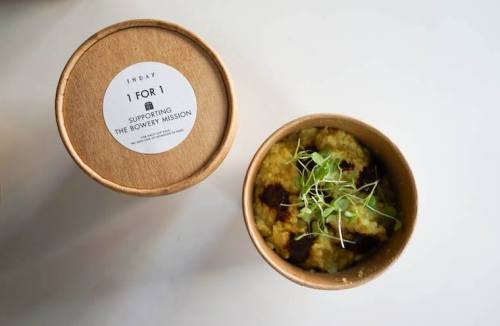
Don’t let the buzz around the bowl fool you: There’s way more to the concept than just a short-lived trend. Just ask Basu Ratnam, owner of New York City’s Indian-inspired fast-casual restaurant Inday, who grew up enjoying his meals out of one. “Everyone fetishizes the bowl now, but that was a meal for us: We had a bowl with a little bit of carbohydrates, a lot of vegetables, a little bit of protein, plant-based or whatever,” he says. “That’s just, to me, the sort of foundation of how we should be eating—and that’s where we try to approach everything from [at Inday].”
So far, so good: Since opening last fall, Inday has quickly become a Flatiron favorite thanks to its almost-too-gorgeous-to-dig-into Ayurvedic-inspired bowls (there’s even a cauliflower “not rice” base) that range from $8 to $12.50 a pop. And there have been new additions to the menu, like their dosa waffles (yes, that’s a thing now—and the crispy gluten-free snack topped with everything from lemon yogurt to smoked salmon from Russ & Daughters is delicious) and daily High Tea, both served starting at 3 p.m.

But one of the most exciting additions to the menu is Inday’s Karma Cup, featuring a risotto-like soup called kitchari. The traditional Indian dish, made up of quinoa, rice, lentils, and spices, was Ratnam’s equivalent of chicken soup as a kid. “If we had a stomach ache, that’s what we would eat. The reason why kitchari is so popular is it’s considered to be a very soothing dish and very easy for your body to break down,” he says.
“Kitchari is really healthy, it’s shelf-stable, it’s all dry goods, and it’s economically a very efficient way to feed people”
His version not only tastes like comfort in a bowl, but provides it to others as well: The Karma Cup is part of the restaurant’s charitable program with the Bowery Mission. For every cup sold, Inday donates one to the homeless shelter’s soup kitchen. “Everyone is looking for different ways to feed people, and it always usually requires vegetables—which is great, but it’s also very expensive, and holding and storing produce is kind of hard,” says Ratnam. “Kitchari is really healthy, it’s shelf-stable, it’s all dry goods, and it’s economically a very efficient way to feed people.”
It’s also become very, very popular among Inday’s regulars. “It just so happens that kitchari is sort of in vogue with the yogi set, but that was more of a coincidence than anything,” admits Ratnam. “We’re hoping that it creates more awareness because this is something we want to do forever.” At $6, you get a nutritious grab-and-go meal and the added bonus of feeding someone else. In other words, it’s good karma all around. —Kristy Mucci
Want to make your own kitchari? Ratnam shared the recipe for Inday’s Karma Cup with us.

“Karma Cup” Kitchari Recipe
Ingredients2 1/2 cups long grain basmati1 1/4 cup red lentils1/2 cup white quinoa1 tsp turmeric1 Tbsp garam masala1/3 tsp asafeotida1 1/2 tsp salt12 cups of waterGhee, chili oil, and microgreens for garnish
1. Soak the lentils and rice for 30-45 minutes before cooking.
2. Preheat oven to 350º F.
3. Mix soaked lentils and rice with quinoa, turmeric, garam masala, salt, and asafeotida together in a pot or dutch oven with water.
4. Cover the pot or dutch oven, put in the preheated oven for 35-40 minutes, stirring every 10-15 minutes until all liquid is absorbed.
5. Serve warm with a drizzle of ghee (clarified butter), chili oil, and microgreens for garnish.
For a little more island flair, you might want to try poké. And no matter what, feel free to take that Instagram photo first (according to a new study, it will make your healthy food taste even better).
Sign Up for Our Daily Newsletter
Get all the latest in wellness, trends, food, fitness, beauty, and more delivered right to your inbox.
Got it, you've been added to our email list.










